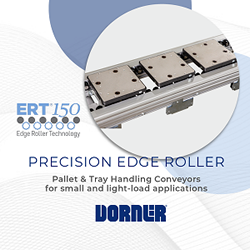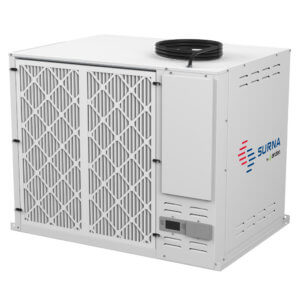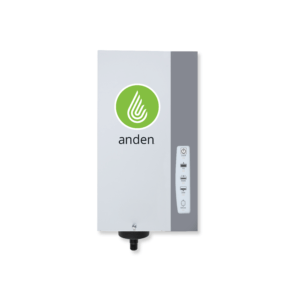Depending on your situation, you will most likely need to use dehumidifiers to remove excess moisture from your grow room environment. But, there are many factors to consider such as HVAC approach, sizing, and quality. Let's examine these factors.
Do I Need a Dehumidifier for Cannabis?
Article from | Surna
Cannabis is a plant that thrives in mid-to-high-humidity environments. Typically, ideal humidity levels for cannabis range between 55-75% relative humidity (depending on strain, temperature, and stage of the growth cycle).
When growing cannabis indoors, you’ll want to simulate the conditions of its native climate as much as possible, while also making timely adjustments to parameters to elicit the highest yielding and best quality response from the plant.
And although cannabis responds best to moderate amounts of humidity in the cultivation space, you must prevent your humidity levels from rising too high. This is especially critical during the vulnerable weeks of dense bud production during the second half of flower.
To achieve this, you must maintain a balance between air conditioning, the heat that lights and other equipment give off, the transpiration rates of the plants, and the amounts of water being introduced to the grow space.
Depending on your situation, you will likely need to incorporate dehumidifiers into your mechanical design.
What is a Dehumidifier?
Your dehumidification requirements, or dehumidification load, is based on your plants’ transpiration rates, which are directly connected to irrigation volume, and any evaporation of water not being used by plants (such as run-off that isn’t drained from the room).
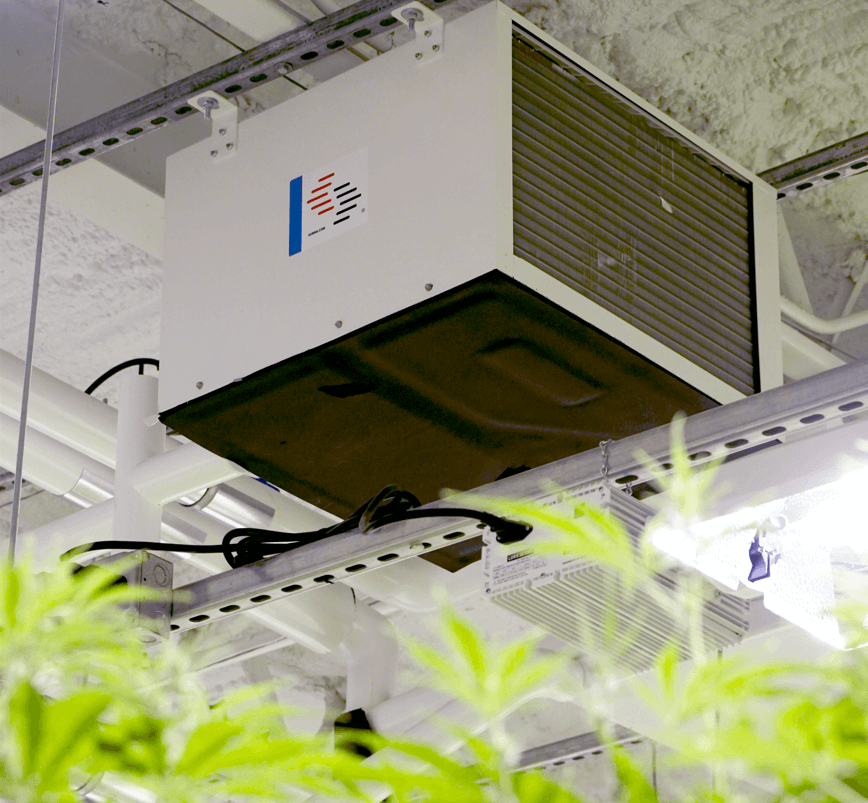
Actual transpiration rates will vary through the plants’ growth cycle. But for the purpose of sizing dehumidification systems, it’s safest to assume that you will need to remove every gallon of water you provide to your plants via your dehumidification system.
A dehumidifier is a piece of equipment that removes excess moisture from the air. Typically, these machines draw water vapor from the air and condense it into liquid water that can then either be drained away or returned for conditioning.
While dehumidifiers are used in homes and other commercial spaces to control humidity levels, it’s important that you choose a unit that is specifically designed to handle the unique challenges of indoor cultivation humidity control.
How Does a Dehumidifier Work?
Most cannabis cultivators use condensing dehumidifiers. These units use a fan to intake moist air from the grow space. Then, as it passes through its cooling coils, the air cools below what is called the “dew point temperature” of the room.
In simple terms, “dew point” refers to the temperature of the air at which water vapor condenses from gas into liquid. This is the temperature at which the air is saturated with moisture. The dew point temperature in the space varies and is a product of the temperature and humidity in the room. As these two values change, so will the dew point temperature.
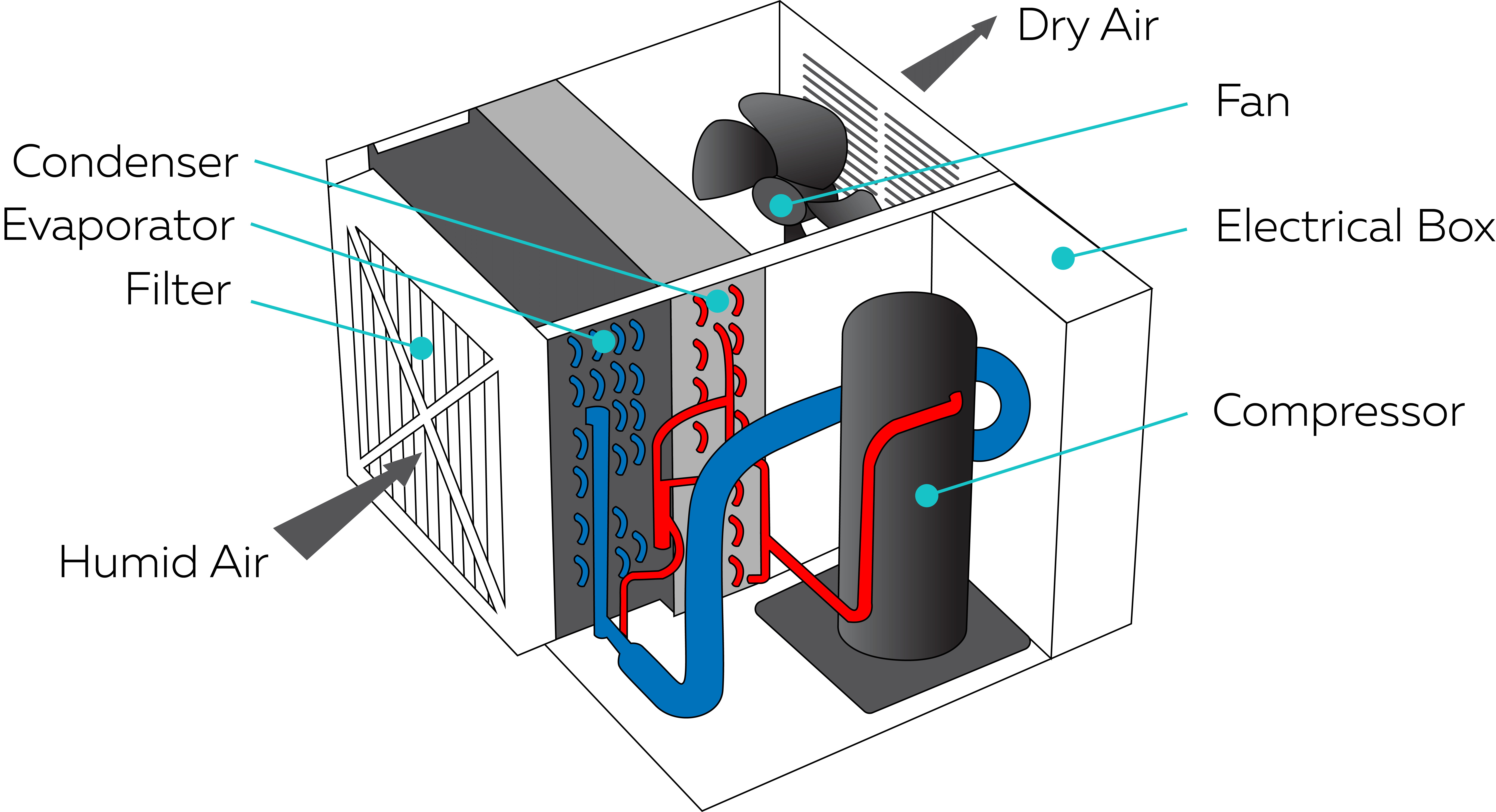
Once the air temperature is reduced to the dew point temperature, moisture is “wrung out,” causing the water to be released as water droplets which form on the coil. The air is returned to the room, and the water is drained away.
Your dehumidifier may not function as it should if it does not have access to adequate airflow or if it is installed improperly, or if it’s located in an area where the humidity is so low that the coil can’t bring the temperature below dewpoint.
Also, every unit is different and will be rated for certain temperature and humidity parameters. If you try to push it beyond its intended capacities, your unit will likely consume more energy, underperform, and may ultimately fail prematurely.
Also, improper installation can lead to leaks and machine malfunctions, so it’s important that you use an installer with experience with dehumidifiers.
If you want to get the most out of your dehumidifier, hire a professional to help determine where it should be located in the space. Professional companies have experienced technicians who are trained to install a dehumidifier properly, and they can work with the mechanical engineer or general contractor to ensure the system is well-coordinated.
Do You Need a Dehumidifier for Cannabis Cultivation?
While virtually all sealed cultivation environments require some form of dehumidification, not all growers use standalone dehumidifiers.
Some climate systems come with dehumidifying capabilities built-in. And even with built-in dehumidification, supplemental standalone dehumidifiers may still be required. But, there are many factors to consider before deciding which route you should take.
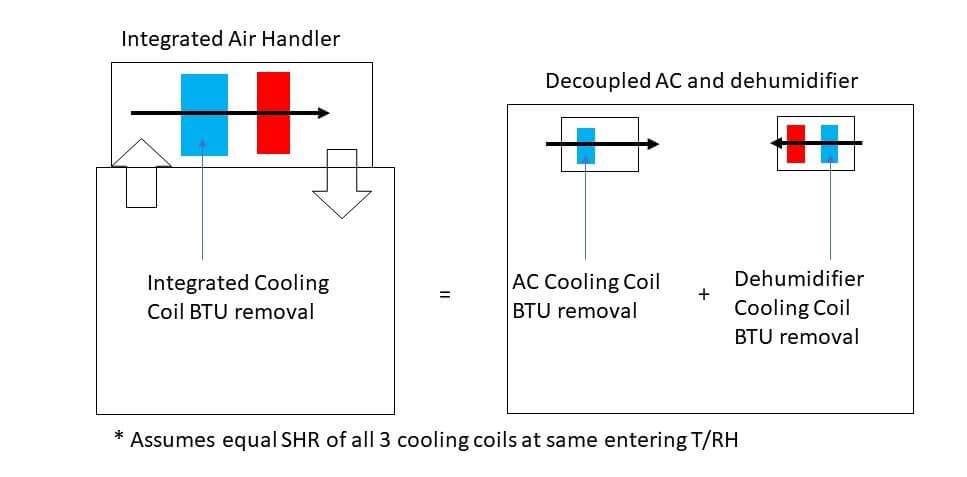
Standalone Dehumidifiers
Overall, the major benefits of standalone dehumidifiers vs. integrated systems are:
- Lower CapEx
- Simple controls
- Versatile options
Standalone units offer separate humidity control and operate independently from your cooling system. They are typically mounted from the ceiling, but they can also be mounted to walls or even placed on the ground for portability, depending on the unit.
They range dramatically in size, with commercial dehumidifiers ranging from less than 100 PPD (pints per day) to over 700 PPD. They also vary in energy consumption and quality.
Because these systems use separate units to achieve cooling and dehumidification, each with their own compressors and cooling coils that require electricity to function, standalone systems tend to require more electrical infrastructure than an integrated system. In fact, dehumidifiers can actually contribute small amounts of heat back into the grow space as a byproduct of operation, adding to the AC load.
However, standalone systems may be less expensive up-front than integrated systems. This is because integrating cooling and dehumidification requires a more complex machine.
HVACD technology approaches that generally rely on standalone dehumidification include:
- DX air conditioning units
- 2-pipe chilled water systems
Integrated Dehumidification
Overall, the major benefits of integrated dehumidification are:
- Lower Electrical Infrastructure
- Sophisticated control
- Precise parameters
Integrated dehumidification refers to systems in which the central HVACD unit combines the ability to cool and dehumidify the cultivation space. Modulating fans and cooling media allow the unit to respond to varying loads as needed as opposed to an on/off switch.
These systems minimize heat waste and limit the number of compressors and cooling coils being used. This may reduce operating and maintenance costs and improve precision, although they can be more expensive to purchase due to their complexity.
If your integrated mechanical system is properly designed, you will be able to significantly reduce or entirely eliminate standalone units.
However, depending on the design approach, you may still purchase supplemental dehumidifiers to keep your humidity in check. You may also end up buying dehumidifiers later on if you make changes that were not originally taken into consideration during your initial design like changing watering rates, deviating from the temperature and humidity setpoints the system was designed for, or increasing the number of plants per room.
Your engineer may also incorporate supplemental units in your dry rooms. Because proper control over humidity is an integral part of the drying process, you may need extra help in drying out your flower.
HVACD technology approaches that integrate cooling and dehumidification include:
- Hot gas reheat units
- 4-pipe chilled water systems
What Kind of Dehumidifier is Best for Cannabis Plants?
There are many dehumidifiers available to growers of all sizes. If you are growing on a commercial scale, your mechanical engineer will recommend which units to use, but you can also work with them if you have your heart set on a particular brand. Each unit will differ in size, performance, energy efficiency, quality, and of course price.
Size and PPD
Cultivation-specific dehumidifiers come in all sizes. Some are designed for small spaces such as grow tents, while others can remove upwards of 700 PPD. Your sizing needs will depend on:
- Size of your grow space
- Number of plants
- Number of lights
- Water volumes
- HVAC design approach
- Desired humidity, temperature, and VPD parameters
Surna by Anden 710 PPD Dehumidifier
Keep in mind that most cannabis dehumidifiers are tested at 80°F/60% relative humidity (RH), (or a dew point temperature of 65°F), and their dehumidification capacities will reflect their performance at those setpoints. That means that if your desired climate parameters are not 80°F/60% RH, which is usually the case as ideal temperature and humidity levels change throughout the growth cycle, your capacity will also change.
If you are seeking very low temperature or humidity in the space which pushes the dew point temperature to below the dew point that the condensing units are capable of achieving, you may opt for a desiccant dehumidification system instead of condensing units.
Desiccant dehumidifiers function by removing moisture from the air through adsorption or absorption rather than by condensing, and are more effective at extremely low dew point temperatures. However, they are usually more expensive, and require more maintenance than condensing units. Consult your HVACD designer for advice if you’re not sure which type of unit is right for you.
Performance
Even when comparing two units of the same size, the way they operate can make a big difference. Typical variations that affect performance and energy efficiency include controls and components.
Especially for commercial-scale growers, digital controls are a must-have. Most medium-to-large units will come with in-box controls, but the capabilities of those controls can vary between manufacturers. If you plan to integrate your dehumidifiers with a facility management controller such as SentryIQ, be sure to confirm that the controls system designer knows what you are planning to use so they can coordinate their design correctly.
If you are seeking a unit with more consistency and better energy efficiency, look for a dehumidifier that uses an electronically commutated motor (ECM) blower, rather than a single-speed blower. The difference between the two is similar to using cruise control in your car. As with an ECM blower, cruise control maintains a setpoint by gradually adjusting how much power is needed, conserving energy. A single-speed blower simply turns on when there is a deviation from the setpoint and turns off once its corrected. This stop-and-go uses more energy and leaves more room for deviation from the setpoints, which can have a ripple effect on the HVAC system.
Similarly, units with a thermal expansion valve (TXV) offer a more efficient and precise way of regulating the flow of refrigerant than capillary tubes, which helps maintain performance across the temperature spectrum. This is because TXV openings can adjust in response to the environment, whereas capillary tubes are fixed.
Quality
Other components may not necessarily affect performance directly, but may serve to improve longevity. For example, epoxy coated high-efficiency coils can help with moisture release and protect the coil from corrosion. So it can pay off to examine not just the overall quality of the unit, but also the quality of its parts.
When shopping for cannabis dehumidifiers, plan ahead. If a part fails, can you easily replace it without having to replace the entire unit? What are other customers saying about the manufacturer’s customer support?
Differences between warranties can serve as indicator of the company’s faith in the quality of its product. Typical warranties will cover parts for one-year, but some brands offer full 5-year warranties, including the refrigerant system.
And of course, look for the unit’s certifications. Quality testing indicators like ASHRAE, ETL, UL, and Energy Star can help indicate not only the unit’s quality, but also support the manufacturer’s claims regarding performance.
Do You Need a Humidifier for Cannabis Cultivation?
If your cannabis facility is located in a particularly dry climate, if your plants are small and seeking higher humidity with very little irrigation volume, or if the AC system has removed too much humidity as a byproduct of cooling (which is only likely when you are are at a high-humidity growth stage with limited irrigation volume), you may need to actually introduce moisture back into your climate.
Steam Humidifier by Anden
When humidity levels are too low, your plants can dry out and transpire moisture too rapidly, and other problems may arise. To keep your VPD levels in check, you can add grow room humidifiers. These usually work by mounting to a wall and injecting humidity into the space. The added humidity is then distributed throughout the room as it is picked up by fans on the walls and ceiling.
Some humidifiers can be installed within the ductwork to offer a more even distribution of water vapor, but be careful as this can create hard-to-clean breeding grounds for bacteria and mold. In these instances, we recommend using sterile steam humidifiers. In any event, it’s best to utilize non condensing humidifiers to ensure that only mist or steam, and not liquid water droplets, are being introduced into the space.
Pre-treating the water supplied to your humidifiers will reduce maintenance requirements and increase the longevity of your humidifier. If you are not using a sterilizing steam humidifier, it may be beneficial to pre-sterilize the water before it is used for humidification.
Conclusion
While standalone dehumidifiers may not be applicable in every indoor grow, dehumidification of some kind will be necessary. Dehumidification is an integral part of indoor cultivation operations and should be carefully selected to meet your needs.
Remember that humidity levels are part of the overall grow room environment, and must be treated as a part of a whole. We recommend working with an experienced team of indoor-ag professionals to help guide your equipment selection process.
The content & opinions in this article are the author’s and do not necessarily represent the views of AgriTechTomorrow
Comments (0)
This post does not have any comments. Be the first to leave a comment below.
Featured Product
